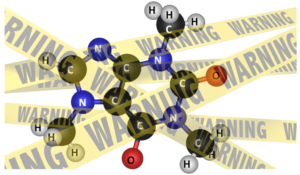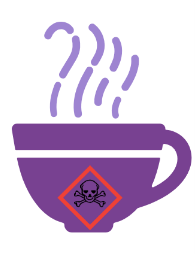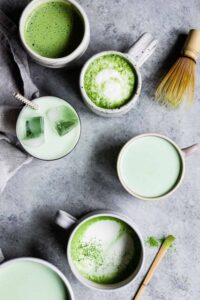
Coffee, tea, energy drinks, or chocolate, wherever you get your fix, caffeine is undoubtedly a staple in most people’s daily life. From the early morning hours to late nights, caffeine has been used as a legal stimulant for waking up in the morning, being productive at work or achieving the next great personal record at the gym. Historically, caffeine application has spanned beyond morning fog. For example, in 1861, an article in the Atlanta Medical Surgery Journal published a 2-page summary of an attempted opioid overdose reversal using caffeine. It was commonly prescribed as a headache remedy for patients suffering from migraines and was used as a snail and slug repellent for people with gastropod infestations. The shift and onset of caffeine consumption sharply increased at the turn of the century in the United States and worldwide. The shift in consumption could be attributed to longer working hours, electricity being implemented at work facilities, and better trade route establishment that allowed for distribution of products around the world. Folger’s and Maxwell House opened in the 1800’s serving instant and drip coffee to the everyday person. Caffeine has been consumed in many forms dating back several thousand years. In 1000 A.D., ground coffee beans would be mixed with fat paste as a rudimentary caffeine bar to keep travelers awake and alert on long journeys. Travelers to the middle east in the 1500’s were introduced to cahve, a modern version of unfiltered coffee. Tea has been traced back as far as 750 A.D. in China where it was noted to cause alertness and have mood-elevating effects in literature. With the history of caffeine so prevalent, it can be assumed that it is safe. After all, no one has ever died from drinking too much coffee…right?
Caffeine Regulations
The regulation of coffee, tea and other caffeinated beverages is complex in the United States. In fact, it was rather unexpected that regulations would be implemented on caffeinated products since a spokesperson for the FDA stated, “existing rules never anticipated the current proliferation of caffeinated products”. In the U.S., beverages containing naturally derived caffeine are not under strict regulation for caffeine limitations, while sodas and carbonated beverages have a 71 milligram caffeine limit per 12 ounces. This is the reason a lot of energy drinks claim natural products such as taurine, ginger,

and other natural products on their labels. Recently, the energy drink released under the “Prime” brand, which rapidly gained popularity with younger consumers (people under age 14), has come under significant scrutiny due to its absurdly high caffeine content (200 milligrams of caffeine in a single, 12 ounce can). This drink, like many other energy drinks, was not under regulation for caffeine content due to the “natural” products it contained. However, Congress has taken steps to potentially set a precedent regulating caffeinated products of all kinds by opening an investigation into Prime and its health effects on younger consumers. Although the warning label on some Prime high caffeine content products does state it is not for children under 18, pregnant or caffeine sensitive people, the probe into the caffeine content for unregulated products may be changing soon. With stricter regulations looming over the caffeine world, have the negative health benefits been overlooked long enough?
Health and Safety

If you’ve ever had to get up early for work, school, or some other morning obligation, you know the struggle of overcoming the morning brain fog. Often, coffee is the first drink people have in the morning. The “coffee cycle”, as it is called, is the immediate ingestion of coffee first thing in the morning and has contributed to increased sleep issues such as interrupted sleep cycles, reduced daytime performance and increased caffeine tolerance resulting in an increased need for higher and higher doses. Cortisol is a natural hormone that aids with getting out of bed and moving around in the morning. The adrenal glands that produce cortisol are exasperated with the use of caffeine and have a negative loop on natural cortisol production when caffeine is regularly consumed first thing in the morning. Caffeine has also been linked to an elevated risk of developing hepatocellular, breast, stomach, and rectal cancer. Caffeine can especially cause issues in pregnant people and those who are sensitive to caffeine. Undoubtedly, these issues associated with caffeine and caffeinated products are serious but sometimes it can be difficult to discern fact from fiction.
Caffeine Myths
One common myth making the rounds on TikTok and other social media apps is that caffeine induces sleepiness in people with ADHD. However, no current scientific studies have shown that caffeine causes such issues. Another myth is that coffee stunts growth. Although osteoporosis, reduction in bone density related to age, has been known to develop in coffee drinkers, there is no direct evidence that children’s growth is stunted due to caffeine intake. Coffee causing cancer is another myth recently discussed on some NPR stations. The caffeine in the coffee was not what contributed to the increased rate of cancer development, but instead, it was the temperature of the coffee that was consumed. Hotter coffee resulted in more irritation and mutation of skin cells in the throat which led to increased cancer risk. All this talk of caffeine and the associated health issues may scare average consumers away from the local Starbucks but some safer and potentially more palatable caffeine alternatives that have been increasing in popularity.
Coffee and Tea Alternatives

Products such as matcha tea, yerba mate and yaupon tea are considered some natural and less concentrated sources to get a caffeine fix without having to ingest bean water. Since these products have lower overall caffeine content and are natural sources, they tend to have a lower caffeine spike and longer duration over energy drinks or coffee. These products have also been used to help high caffeine tolerant people weed down their intake without complete caffeine withdrawal. Chocolate, depending on how it is manufactured, can contain low doses of caffeine that are significantly less than a cup of coffee but may just be enough to get someone through their slow workday. If a small pick-me-up is all you need, coffee is no longer your only option. For all my fellow coffee and tea drinkers, do not be alarmed. Although highly caffeinated products add risks to general health, moderation, and conscious consumption can make a big difference.
Peer editors: Devan Shell & Yolanda Yang